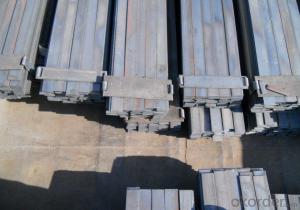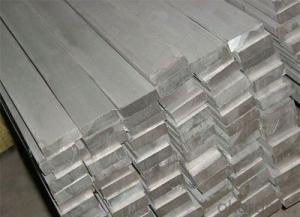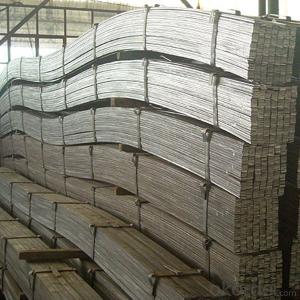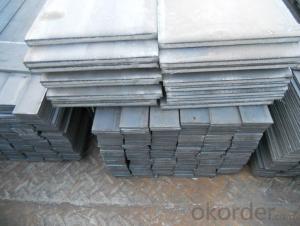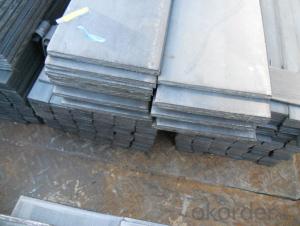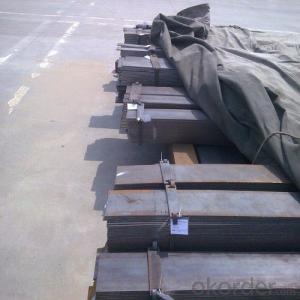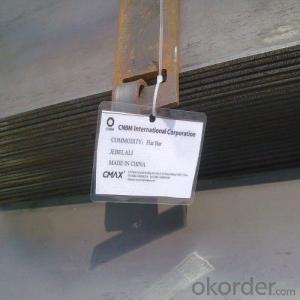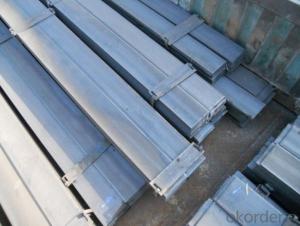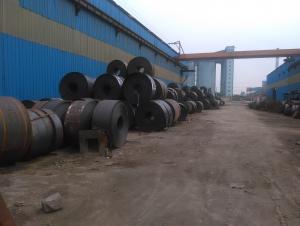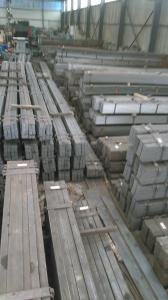Hot Rolled Flat Steel Bar in Q235B High Quality
- Loading Port:
- Tianjin
- Payment Terms:
- TT OR LC
- Min Order Qty:
- 25 m.t.
- Supply Capability:
- 10000 m.t./month
OKorder Service Pledge
OKorder Financial Service
You Might Also Like
OKorder is offering high quality Flat Bar at great prices with worldwide shipping. Our supplier is a world-class manufacturer of steel, with our products utilized the world over. OKorder annually supplies products to European, North American and Asian markets. We provide quotations within 24 hours of receiving an inquiry and guarantee competitive prices.
Product Applications:
Flat Bars are ideal for structural applications and are widely used in the construction of buildings and bridges, and the manufacturing, petrochemical, and transportation industries.
Product Advantages:
OKorder's Flats Barare durable, strong, and resist corrosion.
Main Product Features:
· Premium quality
· Prompt delivery & seaworthy packing (30 days after receiving deposit)
· Corrosion resistance
· Can be recycled and reused
· Mill test certification
· Professional Service
· Competitive pricing
Product Specifications:
Manufacture: Hot Rolled
Grade: Q195 – 235
Certificates: ISO, SGS, BV, CIQ
Length: 6m – 12m, as per customer request
Packaging: Export packing, nude packing, bundled
Chemical composition of Q235
Alloy No | Grade | Element(%) | ||||
C
| Mn
| S
| P
| Si
| ||
Q235
|
B
|
0.12—0.20 |
0.3—0.7 |
≤0.045 |
≤0.045
|
≤0.3
|
Physical properties of Q235
Alloy No | Grade | Yielding strength point(Mpa) | Tensile strength (Mpa) | Elongation after fracture(%) | ||||||
Thickness (mm) | Thickness (mm) | |||||||||
≤16 | >16--40 | >40--60 | >60--100 | ≤16 | >16--40 | >40--60 | >60--100 | |||
≥ | ≥ | |||||||||
Q235 |
B |
235 |
225 |
215 |
205 |
375--500 |
26 |
25 |
24 |
23 |
FAQ:
Q1: How soon can we receive the product after purchasement?
A1: Within three days of placing an order, we will begin production. The specific shipping date is dependent upon international and government factors, but is typically 7 to 10 workdays.
Q2: How do you guarantee the quality of our products?
A2: We have established an advanced quality management system which conducts strict quality tests at every step, from raw materials to the final product. At the same time, we provide extensive follow-up service assurances as required.
Q3: The prices are invoicing on theoritical weight or on actual weight?
A3: We can do it in both manners, according to the customers' request.
Images:
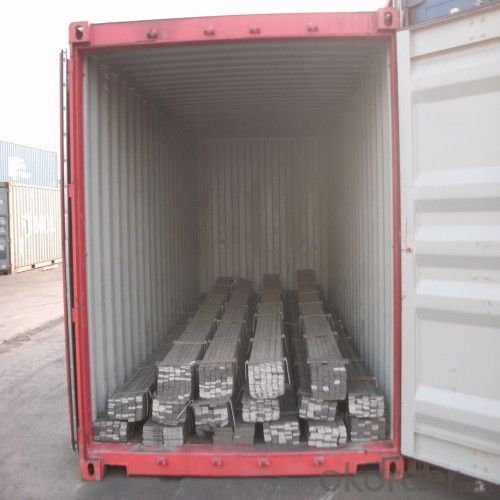
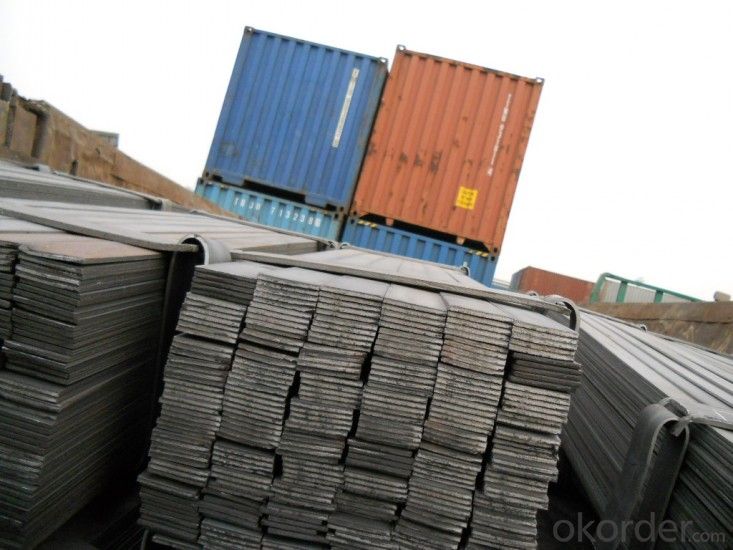
- Q: Are steel flat bars suitable for making architectural elements?
- Yes, steel flat bars are suitable for making architectural elements. They are versatile, durable, and can be easily shaped and manipulated to create various architectural designs and structures. Additionally, steel flat bars offer high strength and stability, making them an ideal choice for supporting heavy loads and providing structural integrity in architectural projects.
- Q: Are steel flat bars available in different surface finishes?
- Steel flat bars come in various surface finishes, providing different options for buyers. Some examples of common surface finishes for steel flat bars are mill finish, hot rolled, cold rolled, brushed, polished, and galvanized. Each surface finish possesses its own distinct characteristics and is suitable for different purposes. Mill finish is the initial surface finish achieved after manufacturing steel, while hot rolled steel flat bars have a rougher texture and are commonly used for structural applications. On the other hand, cold rolled steel flat bars have a smoother surface finish and are often utilized in decorative applications. Brushed and polished finishes offer a more refined and aesthetically pleasing appearance. Meanwhile, galvanized steel flat bars are coated with zinc to provide protection against corrosion. In summary, the availability of various surface finishes allows steel flat bars to be utilized in a wide range of applications, while also meeting specific requirements for appearance and functionality.
- Q: Can steel flat bars be used for decorative purposes?
- Yes, steel flat bars can definitely be used for decorative purposes. Due to their sleek and modern appearance, steel flat bars can add an industrial and contemporary aesthetic to various applications. They can be used to create decorative accents such as railings, trimmings, and ornamental details in both indoor and outdoor settings. Steel flat bars can be easily shaped, bent, and welded to achieve different artistic designs, making them versatile for decorative purposes. Additionally, their durability and resistance to corrosion make them suitable for long-lasting and low-maintenance decorative elements. Whether it's for architectural features, furniture, or artistic installations, steel flat bars provide a visually appealing and functional option for decorative purposes.
- Q: How can copper cables and flat steel be welded together?
- If it is filamentous, press press terminal (open type to cut tin). The terminal is pressed onto flat steel for corrosion protection. It is not allowed to be directly pressed to flat steel, so it must be brazed to flat steel by copper
- Q: Can steel flat bars be used for making construction equipment or vehicles?
- Yes, steel flat bars can be used for making construction equipment or vehicles. Steel flat bars are versatile and commonly used in various industries, including construction and automotive. They offer high strength, durability, and excellent load-bearing capabilities, making them suitable for manufacturing heavy-duty equipment and vehicles. Steel flat bars can be shaped, cut, and welded to meet specific design requirements, allowing for the creation of custom components and structures. Additionally, their corrosion-resistant properties ensure longevity, making them a reliable choice for construction equipment and vehicles subjected to harsh environments and heavy use. Overall, steel flat bars are a popular material for construction and automotive applications due to their strength, versatility, and reliability.
- Q: How do steel flat bars perform in terms of strength and durability?
- Steel flat bars are known for their exceptional strength and durability. Due to their solid construction and high carbon content, steel flat bars exhibit superior tensile strength and resistance to bending, making them ideal for applications that require robust support or load-bearing capabilities. Additionally, their resistance to corrosion and wear ensures long-term durability, making steel flat bars a reliable choice for various structural and industrial purposes.
- Q: How do you determine the creep resistance of a steel flat bar?
- To determine the creep resistance of a steel flat bar, several steps are typically followed. Firstly, it is important to understand what creep is. Creep refers to the deformation or gradual change in shape that occurs in a material over time under constant stress or load. It is a critical consideration for materials like steel, especially when used in applications that involve sustained high temperatures or long-term stress. To test the creep resistance of a steel flat bar, a common method is to conduct a creep test. This involves subjecting the bar to a constant load or stress over an extended period, typically at elevated temperatures that simulate the conditions it will be exposed to in its intended application. During the test, the deformation or change in length of the flat bar is measured over time. The creep rate, which is the rate of deformation, is calculated by dividing the change in length by the time elapsed. This provides valuable information on the material's ability to resist creep under specific conditions. The test typically involves applying a constant load or stress to the steel flat bar and subjecting it to high temperatures for a predetermined period, often several hundred or thousand hours. The temperature and stress levels are selected based on the application requirements or industry standards. Additionally, various factors such as the composition of the steel, including its alloying elements and impurities, play a crucial role in determining its creep resistance. Therefore, analyzing the chemical composition of the steel flat bar is also important in assessing its creep resistance. Furthermore, it is essential to consider the microstructure of the steel. Microstructural characteristics like grain size, distribution, and orientation can significantly impact the creep resistance. For instance, steel with a fine and uniform grain structure tends to exhibit better creep resistance compared to those with larger grains. Ultimately, determining the creep resistance of a steel flat bar requires conducting a creep test, considering its chemical composition, and evaluating its microstructure. This comprehensive approach ensures a thorough understanding of the material's behavior under sustained loads and high temperatures, enabling informed decisions for its application in various industries.
- Q: What are the maximum and minimum widths for steel flat bars?
- The maximum and minimum widths for steel flat bars can vary depending on the specific standards and requirements set by manufacturers and industry standards organizations. However, there are generally accepted ranges for these dimensions. In general, the maximum width for steel flat bars is typically around 12 inches (30.48 cm). This allows for the manufacturing of larger and wider flat bars that can be utilized in various applications such as construction, industrial machinery, and manufacturing processes. On the other hand, the minimum width for steel flat bars can vary depending on the manufacturing capabilities and requirements of specific industries. However, it is common to find steel flat bars with a minimum width of around 1 inch (2.54 cm) or even smaller. It is important to note that these maximum and minimum widths are not absolute and can be subject to variations based on specific manufacturing processes, material thickness, and customer requirements. Therefore, it is always recommended to consult the relevant industry standards, manufacturer specifications, or engineering professionals to determine the exact maximum and minimum widths for steel flat bars in a specific application.
- Q: What are the different types of surface finishes for aluminum steel flat bars?
- There are several types of surface finishes available for aluminum steel flat bars, including polished, brushed, anodized, mill finish, and powder coated.
- Q: Are steel flat bars suitable for architectural applications?
- Yes, steel flat bars are suitable for architectural applications. They offer excellent strength, durability, and versatility, making them ideal for various architectural designs. Additionally, steel flat bars can be easily customized and fabricated to meet specific architectural requirements, making them a popular choice among architects and designers.
Send your message to us
Hot Rolled Flat Steel Bar in Q235B High Quality
- Loading Port:
- Tianjin
- Payment Terms:
- TT OR LC
- Min Order Qty:
- 25 m.t.
- Supply Capability:
- 10000 m.t./month
OKorder Service Pledge
OKorder Financial Service
Similar products
Hot products
Hot Searches
Related keywords
